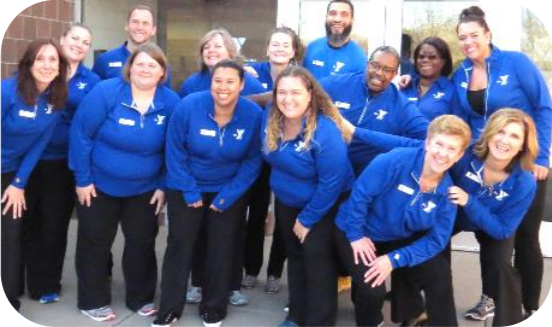

Bob, not in the proper uniform
Bob Thomas is the chief experience officer for the YMCA of the Greater Twin Cities, a leading nonprofit dedicated to strengthening communities through youth development, healthy living, and social responsibility. He is responsible for engaging community members to help them meet their personal goals while ensuring a great Y experience through integrated marketing, membership sales, and healthy living programs including swim lessons, group exercise, personal training, chronic disease prevention, and healthy aging. Prior to joining the Y, Bob held marketing, sales, and sales operations leadership positions at Boston Scientific. He holds a bachelor’s degree in economics and English from the University of St. Thomas. Bob serves as the chair of the board of The Sheridan Story and actively volunteers at Colonial Church of Edina.
Bob recently led a rollout of new uniforms for the Y’s employees, referred to as team members. The goal was to influence team members to better engage with customers and further increase their pride in the Y brand. Team branding creates a work environment where every decision and every behavior embodies the specific attributes of the brand. We asked him more about the move to the new uniforms.
You recently led a change to the YMCA team uniforms. Could you tell us a little about the background of the uniforms, and why it was time for a change?
About six years ago, the Y switched from their old, black-and-red logo to a dual-color logo that uses five different color combinations, which was meant to symbolize diversity and flexibility. The change in logo came with a change in uniform: At the time the decision was made to embrace all of the colors of the new brand, so the uniforms consisted of polo shirts that came in a variety of colors, but were primarily white—which meant they showed dirt, and looked bad even after very little basic wear-and-tear. To add to that, they didn’t fit very well, and team members soon began to express their disappointment with the required uniform. The uniform became known as the “bowling shirts.”
Wow, it sounds like a challenging situation. What first steps did you take to start to fix this?
After forming a cross-functional team, the first thing we did was look for research on the effects of uniforms on both employees and customers. This was a critical step—originally I’d been thinking we should go a more formal route for the new uniforms, but what we discovered is that research shows that the formality of a uniform isn’t necessarily that important. From the customer’s perspective, all that really matters is that an employee’s uniform is more or less what they expect—so, no bankers in sweatpants or plumbers in a three-piece suit. From the employee’s perspective, what’s really important is that they feel comfortable and confident in what they are required to wear. It turns out that employees are more likely to be more friendly and welcoming, as well as engage longer and perform other basic customer service behaviors, if they’re in a uniform that they’re confident wearing.
The great thing about the Y in this respect is that people already expect everyone to be wearing casual, “gym” clothes—so we could stick with very casual, comfortable uniforms and still match people’s expectations.
The other thing we had to take into consideration is representing the Y’s brand. We’re the most valuable nonprofit brand in the world, and it was important that we made sure our employees were faithfully representing that brand.
Once you knew the parameters of what you wanted the uniforms to be, how did you go about designing the actual uniforms themselves?
Going back to the idea of comfort and confidence, we wanted to give employees options, so they could really like what they were wearing—while at the same time still having a clear and distinguishable uniform. Having a choice not only adds to comfort and confidence, but it also allows them to show some of their individual style. We drew a lot of inspiration from Olympic athletes’ uniforms, actually—each sport has its own style of uniform, but the overall impression is the same, and you can clearly tell they’re all competing for the same country. We wanted to introduce a similar idea to our uniforms, so we came out with eight different styles, in eight different sizes, so each of our employees could choose what was comfortable for them. Plus, we loosened up some of our policies around tattoos, grooming, and shoe color, so team members could feel comfortable with every aspect of what they were wearing to work. As the Y looks to serve a diverse and changing community, having individual team members expressing different individual styles is one way to show the people we serve that they are all welcome here.
How did employees react to the new uniforms?
People were actually really excited—more excited than we had expected, which was great. We got almost no pushback, which, considering we’re dealing with something as personal as clothes, was extremely unexpected. It helped that the old uniforms were so outdated—people just wanted a change.
To introduce the new uniforms, we did a kind of roadshow—we teased the different options to get people excited, and walked through the basics of the changeover. Here’s why we’re doing it, here’s what you need to know, here’s what you can and can’t wear. It helped people not only get familiar with the different option we were offering, but to get excited about them. We positioned the new uniforms as part of a larger cultural shift to better serve our community.
So far, what impact have you seen the new uniforms have?
Only the frontline teams are required to wear the uniform, but we’ve seen more team members who don’t have to wear the uniform also start to wear them, because they’re comfortable and offer choices that allow team members to make the uniform personal to them. That was a big vote of confidence in our design. Just last week we held our semi-annual full time employee meeting, and we asked everyone to wear their new uniforms. As leaders, we talk a lot about being one team, and at this meeting that concept was palpable. It was a sea of blue, and we were all Y team members, no titles, no departments, no different locations. One team—one uniform! Anecdotally, we’ve heard that people are feeling a lot more comfortable and confident, and given the research I mentioned, I trust that they’re engaging customers more because of it.
The whole process was a great way to bring together multiple areas of the organization—leadership, customer experience, marketing, operations, and finance. And we’ve developed a system that, because of its flexibility, is also innately sustainable—as new styles become available we can add them to the list of options, and as older styles become unpopular we can rotate them out. Not only were we able to change the immediate uniform situation, but we were also able to build a sustainable system that will ensure satisfied employees—and therefore satisfied customers—for years to come.

